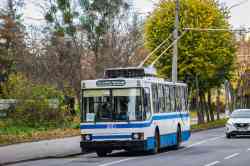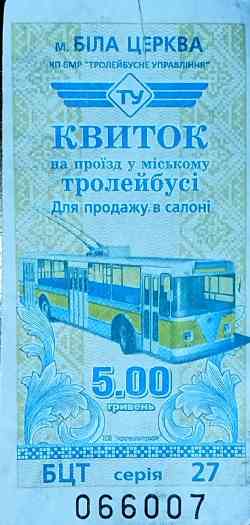 Городской электротранспорт
Городской электротранспортБелая Церковь
Редакторы: Дмитрий Недашковский, andrijmovcan29, Petlyurovsky.
Комментарии: все · троллейбус
Хронология
Быстрый поиск ТСПоиск фото по маршрутуТроллейбусные предприятия
Карты и схемыФотогалереи ГЭТ
Транспортное сообществоИнформация
Белая Церковь расположена в Киевской области, Украина. Население города - ок. 205 тыс. человек. Троллейбусное движение в городе открыто 23 июня 1980 года. Длина первого участка составляла 6,1 км от ул. Павличенко до центральной проходной шинного завода. Движение открывали 12 машин ЗиУ-682В. К 1984 году линия продлевалась еще четырежды, как в одну, так и в другую сторону, т.о. сформировался центральный троллейбусный маршрут города №1 от пл. Победы к железнодорожной станции "Роток". В 1989 году был открыт маршрут №2, который соединил 4-ый микрорайон (Комсомольский массив, ныне - массив Леваневского) c заводами и станцией "Роток". К началу 90х в городе насчитывалось порядка 85 машин ЗиУ-682 разных модификаций. В 1991 - 1993 годах приходит 9 сочлененных троллейбусов моделей Киев-11 и ЮМЗ Т1. Ежедневный выпуск на 2 маршрута составлял 45 - 50 машин. К 1994 году достраивают второй мост через речку Рось и запускают 2 маршрута к новому Таращанскому массиву: 4 и 5. В октябре 2004 года произошло последнее обновление сети - был запущен маршрут, соединивший Песчаный массив с центром города, получивший номер 3. Хотя изначально к открытию планировался гораздо более длинный маршрут до станции Роток. Лишь к 2014 году был открыт маршрут 3а, который связал массив Песчаный со станцией Роток. Примечательно, что при этом короткий маршрут №3 так упразднен и не был. Длина всех троллейбусных линий в однопутном исчислении составляет 44 км. По состоянию на конец 2000х годов троллейбус переживал не лучшие времена - на балансе осталось лишь 26 машин при ежедневном выпуске до 11 единиц на все 5 маршрутов. С 1999 по 2011 год было закуплено всего 2 новых троллейбуса. В связи со спадом производства и сильнейшим экономическим кризисом к 2009 году субвенции государства на погашение льготного проезда стали неполными и крайне нерегулярными. Дотировать управление за свой счет казна города была уже не в состоянии, таким образом долги по выплате заработной платы с каждым месяцем стали все более возростать. Ситуация достигла "пика" в начале апреля 2009 года, когда троллейбусники более 10 дней подряд выстраивали свои машины на центральной площади города. Деньги нашлись. Зарплаты были выплачены, однако государство и впредь не спешило со своевременными выплатами дотаций. По состоянию на конец сентября 2010 года задолженность по выплате заработной платы перед работниками управления составляла более 3 месяцев, в результате чего с 1 по 12 октября ни один из водителей на работу не вышел. К концу 2010 года ситуация с финансированием стабилизировалась, наметились положительные тенденции: в течении полугода три троллейбуса прошли заводской капитальный ремонт, еще 2 прошли качественный средний ремонт, а в июле 2011 года впервые со времен распада Советского Союза выделена сумма на закупку сразу 6 новых троллейбусов. Велись переговоры с представителями компаний-производителей троллейбусов из Луцка (Богдан), Днепропетровска (Мегаполис) и Минска (Белкомунмаш, МАЗ), был объявлен тендер в результате которого победителем было признано ООО "МАЗтранссервис". В конце ноября 2011 года поступил первый в городе троллейбус с низким уровнем пола модели МАЗ-ЭТОН Т103. К началу февраля 2012 года на линию вышли все 6 закупленных машин белорусского производства. За летне-осенний период заводской капитальный ремонт прошли сразу три машины. Выпуск на 1 маршрут увеличен до 9-10 машин, а на 4 до 2. C 2012 по 2016 годы все троллейбусы модели ЗиУ и ЮМЗ прошли качественный капитальный ремонт, что позволило продлить срок их эксплуатации еще на 8-10 лет. 2016 год стал переломным в современной истории белоцерковского троллейбуса. По состоянию на начало года погашена вся накопившаяся задолженность по заработной плате. В марте на заседании исполкома была принята программа по привлечению инвестиций для создания единой автоматизированной системы оплаты проезда — «Электронный билет» и уже 22 июля инвестиционный был подписан договор о создании единой автоматизированной системы оплаты проезда на городском пассажирском транспорте. 27 декабря 2016 года в депо поступило 4 троллейбуса особо большой вместимости бывших в употреблении из Будапешта, согласно утвержденной программы развития электротранспорта. Кроме того, в салоне одного из троллейбусов состоящих на балансе предприятия был установлен первый в городе валидатор системы "Электронный билет". Правила пользования системой "Электронный билет": Перспективная схема развития троллейбусных маршрутов: ПС:
Маршруты:
Видео
Активные фотографы города1-е место: Дмитрий Недашковский — 844 фото2-е место: tavalex2007 — 119 фото 3-е место: Евгений Гура — 56 фото Полный список фотографов |
Случайное фото Новые фотографии     
|
Тёмная тема
Использование фотографий и иных материалов, опубликованных на сайте, допускается только с разрешения их авторов.























